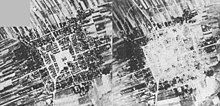Frampol
History
The town was founded in 1717 by Count Marek Antoni Butler, with a unique, highly symmetric layout of streets in the shape of concentric rectangles around a large central square. Its name, originally spelled Franopole, comes from Franciszka née Szczuka, the wife of Count Butler. In 1735, the Jewish community of Frampol already had its own cemetery, and in 1740, Józef Butler funded a wooden church, which since 1778 exists as a separate parish. In the second half of the 18th century, the town belonged to the Wisłocki family. It was an important center of artisans, mostly cloth makers, and all houses were made of timber. In 1789, King Stanisław August Poniatowski established seven annual fairs. Frampol belonged to Lublin Voivodeship in the Lesser Poland Province of the Kingdom of Poland.
The town was annexed by Austria in the Third Partition of Poland in 1795. After the Polish victory in the Austro-Polish War of 1809, it became part of the short-lived Duchy of Warsaw, and after the duchy's dissolution in 1815, it fell to the Russian-controlled Congress Poland. In 1921, already in the Second Polish Republic, the population of Frampol was 2,720.

During the German invasion of Poland at the start of World War II, 90% of the town's buildings were destroyed in a raid carried out by the Luftwaffe on September 13, 1939. During the German occupation, the town's significant Jewish community was murdered in the Holocaust. The town never fully recovered – its population today is less than half of what it was before the war. Frampol, or a fictionalized version thereof, is the setting of many of the best stories of Isaac Bashevis Singer, including Gimpel the Fool. Artist Irene Lieblich illustrated the Market of Frampol in Isaac Bashevis Singer's book 'A Tale of Three Wishes' from her direct memory of the marketplace of Frampol. This is the only known painting of the Frampol Marketplace as it existed before the full destruction by the German Luftwaffe.
Currently, it is one of the smallest towns in Poland. In 1869 Frampol lost its official status as a town, to recover it only in 1993.
References
- ^ "Local Data Bank". Statistics Poland. Retrieved 2022-08-03. Data for territorial unit 0602054.
- ^ Słownik geograficzny Królestwa Polskiego i innych krajów słowiańskich, Tom II (in Polish). Warszawa. 1881. p. 400.
{{cite book}}: CS1 maint: location missing publisher (link)
External links
- Official town website
- Description of Frampol in the Encyclopedia of Jewish Communities in Poland
- Description of the Jewish Cemetery in Frampol
